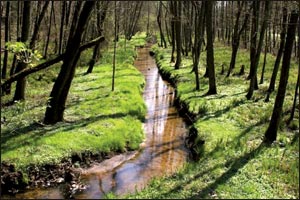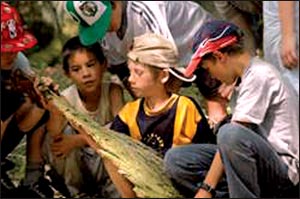|
Man and the biosphere::
Applying the concept literally
The concept of urban ecology is key for the Bliesgau, protected area
in Germany added to the global network of UNESCO Biosphere Reserves on
May 26. The Bliesgau is not the first site to include its urban
elements, but it is the only one where population density is as high as
310 inhabitants per square kilometre.
|

Part of the central area of the Bliesgau Biosphere Reserve
(Germany) Courtesy Detlef Reinhard |
Small, but significant. That's Saarland. If you discount the "city
states" of Hamburg, Berlin und Bremen, it's Germany's smallest Federal
State. Slightly withdrawn in the south-west of the republic, it gives
the impression of being a small appendage of the great German state.
France is its majestic neighbour to the south, and a small snout
noses Luxembourg in the west, but apart from that it's completely
surrounded by the large state of Rhineland-Palatinate.
At the same time, it's one of the warmest corners of Germany, so it's
not surprising, then, that people have settled here for thousands of
years, leaving their traces behind them. The Gollenstein, a
4000-year-old menhir, bears witness to the fact that the region was
occupied as early as the Middle Paleolithic age.
Later on, the Romans led a good life in Saarland. Julius Caesar
originally conquered the land from the Celts, and it was the Romans,
too, who introduced wine to Saarland - the start of a long tradition.
Wine was cultivated in the valley of the River Blies right up to the
first half of the 20th century.
"Bliesgau" is the name of the 370 square kilometre region bordering
on the River Saar in the west, the Rhineland Palatinate in the East, and
France to the south. Travel brochures talk enthusiastically of
"Mediterranean climate" "rolling hills" and "wide orchard meadows". The
shell limestone soil makes Bliesgau unique, and numerous species of
orchids thrive on it.
|

The Bliesgua party |
It is not an untouched natural idyll, however. Humans have shaped the
region. The Bliesgau Biosphere Reserve thus contains 111,000 people,
divided between two towns, St. Ingbert and Bieskastel. The population
density of 310 residents per square metre is above the Federal German
average and also higher than in any other biosphere.
With regard to nature conservation, Bliesgau is nothing special
compared with other biospheres. Measures to protect fauna and flora were
taken long ago. Parts of the region are nature reserves: 43% of the
territory corresponded to protected land even before the site was added
to UNESCO's World Network of Biosphere Reserves.
"But urban natural conservation is also a project we are working on,"
add Detlev Reinhard and Holger Zeck, employees at the Ministry of the
Environment. A number of the species recorded at Bliesgau actually live
in the towns, such as the crested lark, wall lizard, greater mouse-eared
bat, barn owl and common swift. These animals are part of the reserve.
"We want to systematically assess how nature is developing in urban
centres", Reinhard and Zeck say. "What is important to observe is how
species that have moved to the towns change their habits and become
dependent on urban infrastructure, for instance for food."
How is Bliesgau unique?
The urban ecology concept is key for this biosphere reserve. For
Reinhard and Zeck, "It's the vibrant diversity that makes the Bliesgau
so unique. Meadows, valleys and forests shaped the landscape, but, above
all, it was the coexistence of man and nature, and the close integration
with urban regions that made this stretch of countryside so special."
"The situation here can't be compared with other biosphere reserves",
explains Pia Schramm of the Biosphere Association in Blieskastel.
"Many biosphere reserves are very much geared to classical nature
conservation and regional development; and rely strongly, for example,
on the marketing of regional products," Schramm says. "We wanted, in
addition, to show what it means to attain sustainability in urban
systems, too".
|

In Bliesgau, various educational activities and awareness
campaigns encourage sustainable development |
Urban ecology
St. Ingbert, the town in the north of Bliesgau with a population of
40,000, is the model for the close link between town and countryside.
"In St. Ingbert we started to think about biospheres very early on,"
explained Monika Conrad, responsible for the environment and biosphere
section of the Town Development Office. Their citizens were extremely
active on the climate protection front, Conrad said. "There is a solar
initiative which offers assistance to citizens installing solar
equipment on their roofs." And a solar cooperative, whereby citizens who
do not have an available roof of their own can buy shares in the company
that equips public buildings.
This provides yearly income and added motivation to get involved in
such projects. Another example: an area of industrial waste land in the
town has been listed as a model trading estate in line with sustainable
urban development. A block heat and power plant supplies the estate with
heat; the biomass for it comes from the town's compost plant, as well as
ligneous lopping from Bliesgau.
This supplies heat to resident firms, as well as the adjacent
community building and the town hall.
In addition, the public transportation bus system has been greatly
expanded, to make it possible for schoolchildren in the region to get to
school in St Ingbert, and for farmers to reach sales outlets for their
produce in surrounding towns. For those in charge of Bliesgau's
conservation project, sustainability means not just ecological, but
economic and social sustainability as well.
Animal species are currently becoming extinct one thousand times
faster than the natural rate.
Jens Lubbadeh, journalist for Der Spiegel, Germany, The UNESCO
Courier |



